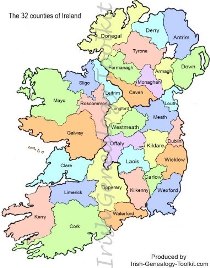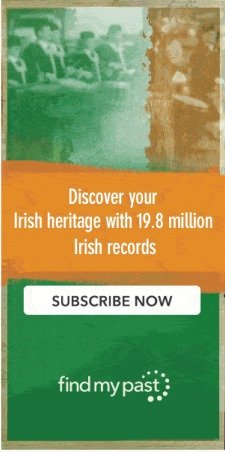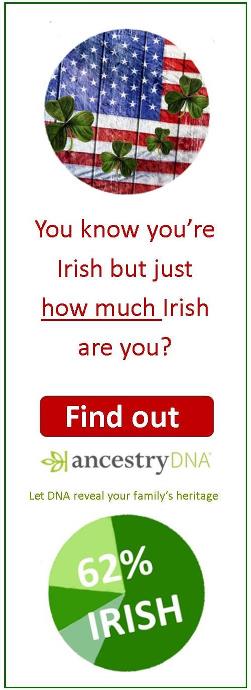- Home ›
- Townland of origin ›
- Counties of Ireland, A-D
Counties of Ireland:
Antrim to Dublin
Below are brief details of the historical counties in Ireland that begin with the letters A to D: from Armagh to Dublin. There is no Irish county name beginning with the letter E.
The nicknames given are principally used in relation to sport, especially those sports under the auspices of the Gaelic Athletic Association, but many of them are also used in daily speech outside of any sporting context.
Antrim
In Irish, the county is called Aon troim, meaning Solitary Place. It is not so solitary these days; with a population density of 199/km2, it is second only to County Dublin and its spectacular Causeway Coast, a UNESCO Heritage Site, is a stalwart of the Irish tourism industry.
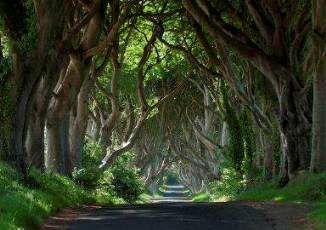 The Dark Hedges, Ballymoney, Co Antrim.
The Dark Hedges, Ballymoney, Co Antrim.Antrim is in the province of Ulster and is part of Northern Ireland (UK). In land area, it is the 9th largest of the thirty-two traditional counties of Ireland. Its main towns are Antrim, Ballymena, Ballymoney, Belfast, Carrickfergus and Lisburn, and the Giant's Causeway is on its north coast.
There are two nicknames for Antrim folk (both usually restricted to sport): the Glensmen and the Saffrons.
Linen manufacturing was once an important industry in Antrim and vast swathes of flax were cultivated in the countryside. (More about Irish Linen and the flax plant.)
Antrim's most common surnames in 1890 were Smith, Johnston, Stewart, Wilson, Thompson, O·Neill, Campbell, Moore, Bell, Robinson, Millar, Brown, Boyd, Scott and Graham.
Griffith's Valuation was carried out in Antrim in 1861.
Armagh
In Irish, the county is called Árd Mhacha, meaning Macha's Hill.
It is situated in the province of Ulster and is part of Northern Ireland (UK), and its main centres of population are Armagh City, Lurgan and Portadown.
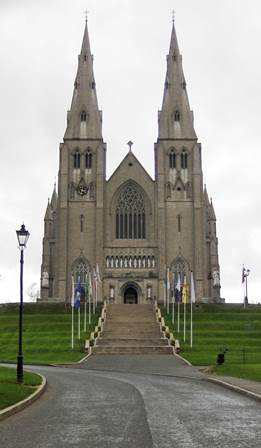 St Patrick's RC Cathedral, Armagh City.
St Patrick's RC Cathedral, Armagh City.In Irish, the county is called Árd Mhacha, meaning Macha's Hill.
It is situated in the province of Ulster and is part of Northern Ireland (UK), and its main centres of population are Armagh City, Lurgan and Portadown.
It has two names: the Orchard County and the Cathedral County, the latter on account of it having two magnificent cathedrals, both called St Patrick's. They face one another on rival hilltops in Armagh City. One is Protestant, the other Roman Catholic.
Surnames associated with Armagh, based on 1890 records, include Murphy, Hughes, Wilson, Campbell, O'Hare, Smith, McCann and Donnelly.
Armagh was the last of the counties of Ireland surveyed by Richard Griffith (in 1864) for his Primary Valuation.
Carlow
In Irish, the county is called Ceatharlach, meaning Four Lakes, and it is the second smallest of the counties of Ireland (the smallest is Louth).
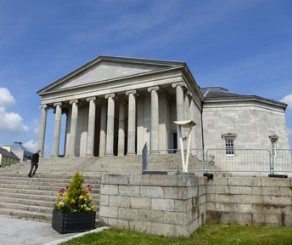 Carlow Town's granite Courthouse dates to 1830.
Carlow Town's granite Courthouse dates to 1830.Located in the province of Leinster, its main towns are Carlow and Bagenalstown. Both are on the River Barrow. For this reason, people from County Carlow are often referred to as Barrowsiders.
They have a few other nicknames, too, among them the Fighting Cocks and the Scallion Eaters.
You may see Carlow referred to as Caterlaugh or Caterlagh on some antique maps.
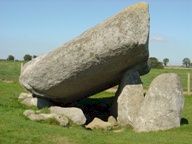
Just outside Carlow Town is Browne's Hill Dolmen, a 5,000-year-old portal tomb that has the biggest capstone in Europe, weighing in at over 100 tons. This is the reason for yet another nickname: the Dolmen County.
Surnames associated with County Carlow, based on 1890 records, include Murphy, Byrne, Doyle, Nolan and Neill.
Griffith's Valuation was carried out in Carlow in 1852-3.
Cavan
In Irish, the county is called Cabhán, meaning a Hollow. The source of the River Shannon and a good scattering of lakes lie within its landlocked borders.
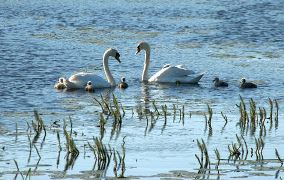
Although in the province of Ulster, Cavan is one of the three counties of Ireland (the others are Donegal and Monaghan) separated from the rest of its province since 1921 when the island was split between Northern Ireland (UK) and the Republic. Cavan is in the Republic and its inhabitants are known by the sporting nickname of the Blues Brothers. The county is also referred to as the Lakes County.
The main settlement in this sparsely populated county is Cavan town, once the stronghold of the O'Reillys who ruled the ancient kingdom of East Breffni.
Based on 1890 records, the most common surnames in County Cavan include Reilly, Smith, Brady, Lynch, McCabe, Clarke, Farrelly, Maguire, Sheridan and Galligan.
Griffith's Valuation was carried out in Cavan in 1856-7.
Clare
In Irish, the county is called Clar, meaning a level piece of land). Clare is one of the west coast counties of Ireland and is in the province of Munster.
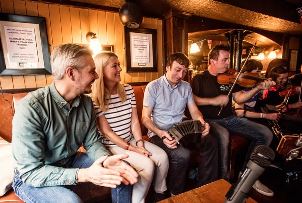 Fleadh Ennis
Fleadh EnnisIts main town is Ennis, a popular destination for tourists hoping to catch an Irish music session.
Other reknowned music centres are Doolin and Lisdoonvarna, on the coast.
Clare is known as the Banner County, on account of the banners displayed at Daniel O'Connell's 'Monster Meetings' in Clare in support of Catholic Emancipation in 1828.
In 2002, the county had of just over 100,000 in 2002, less than two-fifths what it was in 1831.
Based on 1890 records, surnames associated with Clare include McMahon, McNamara, Moloney, O'Brien, McInerney, Kelly, Keane, Murphy, Griffin, Halloran and Ryan.
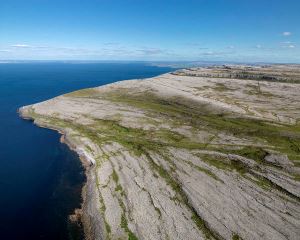 The Burren, Co Clare. (Irish: Boireann / Boirinn, meaning great rock.)
The Burren, Co Clare. (Irish: Boireann / Boirinn, meaning great rock.)Griffith's Valuation was carried out in Clare in 1855.
Among its outstanding geological features are the Burren, Europe's largest area of limestone pavement, and the Cliffs of Moher, one of the major tourist attractions of Ireland.
Many visitors rent self-catering Irish cottages for a week or two to fully explore one of the most unusual and evocative counties of Ireland.
Cork
In Irish, Cork is called Corcaigh, meaning Marsh. Located in the far south west of the island, it is the largest of all the historical counties of Ireland, both north and south, and is in the province of Munster. Its nickname is the Rebel County due to its history of fighting for independence, and its red and white checkered flag is known as the Blood and Bandage.
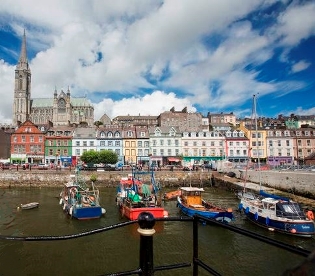 Cobh, the harbour from which millions of Irish people left their homeland bound for North America.
Cobh, the harbour from which millions of Irish people left their homeland bound for North America.Folk from Cork City, which sits on the River Lee, are known as Leesiders.
It was from the city's huge port, then recorded on ship manifests as Queenstown, that many hundreds of emigrants set sail for America. The port is now known as Cobh (pronounced Cove).
Surnames associated with County Cork, based on 1890 records, include Sullivan, Murphy, McCarthy, Mahoney, Donovan, Walsh, O'Brien, Callaghan, Leary, Crowley, Collins, Driscoll, Connell, Barry, Cronin, Buckley, and Daly.
Richard Griffiths carried out his Valuation survey in 1851-53.
Derry - LondonDerry
In Irish,
the county is called Doire, meaning Oak Wood, and explains why Derry is known
as the Oak-leaf County. It is also known as Londonderry.
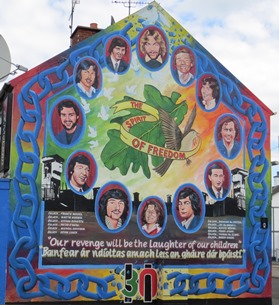
The terms, for both the county and its main town, are interchangeable. It used to be known as County Coleraine.
Derry is in the province of Ulster and is part of Northern Ireland (UK). Among its principal towns are Derry/Londonderry (whose encircling walls were built in 1613), Coleraine, Magherafelt and Ballymoney. Magilligan Strand is Ireland's longest beach (10km/6m).
The county's most common surnames, based on 1890 records, include Doherty, McLaughlin, Kelly, Bradley, Brown, McCloskey, Campbell, Mullan, Smith, O'Neill and Kane.
Derry was surveyed by Richard Griffith for his valuation in 1858-9.
Donegal
In Irish, Donegal is called Dún na nGall, meaning Fortress of the Foreigners. It is one of the three Ulster province counties within the Republic and its principal town is Letterkenny.
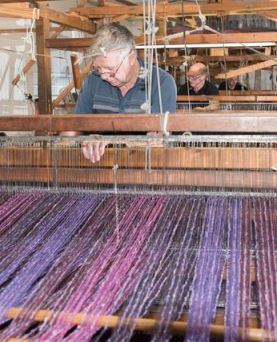 Donegal Studios,in the village of Kilcar, aims to maintain and preserve the long running tradition of hand-weaving in South West Donegal.
Donegal Studios,in the village of Kilcar, aims to maintain and preserve the long running tradition of hand-weaving in South West Donegal.Inishtrahull Island, 7km from the mainland, is the most northerly point of Ireland.
Donegal has two nicknames: O'Donnell County, in reference to the region's medieval lords, and the Forgotten County, on account of its remoteness. People from Donegal are sometimes referred to as Herring Gutters.
Donegal is famous as the home of Irish tweed, and its westerly regions are part of the Gaeltacht (Irish speaking areas).
Surnames associated with County Donegal, based on 1890 records, include Gallagher, Doherty, Boyle, O'Donnell, McLaughlin, Sweeney, Ward, Kelly, McGinely, McFadden, McGowan, Duffy and Campbell.
Griffith's Valuation was carried out in 1857.
If you've got Donegal ancestors, be sure to check out Donegal Genealogy, a free website run by Lindel Buckley and full to the brim with links to Donegal sources.
Down
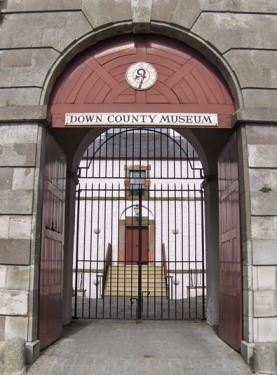 Down County Museum is housed in an 18th-century former prison in Downpatrick.
Down County Museum is housed in an 18th-century former prison in Downpatrick.In Irish, the county is called Dún, meaning Fortress. It is in Ulster province and is part of Northern Ireland (UK). Its principal towns are Banbridge and Newry (where, in 1578, the first Protestant church in Ireland was built).
Although many counties of Ireland have associations with St Patrick, Down has the deepest connections with the saint as this was where he landed in AD432 and first preached to the locals. It is known as the Mourne County, in reference to the stirring scenery of the Mourne Mountains.
The county's most frequently occuring surnames, according to an 1890 survey, were Thompson, Smith, Campbell, Patterson, Martin, Wilson, Graham, Johnston and Murray .
Richard Griffith surveyed Down for his Valuation in 1863-4.
Dublin
Dublin is in the province of Leinster and home to the sprawling capital city where more than a quarter of the Republic's population now lives. The city that was to become this capital was first settled by Celts in AD140 and became a Viking base in AD860. The former settlement was known as Ath Cliath, meaning Hurdle Ford; this is the Irish language name for the city. The Viking settlement was known as An Dubh Linn, meaning Black Pool of Water; the anglicised version of this name is Dublin.
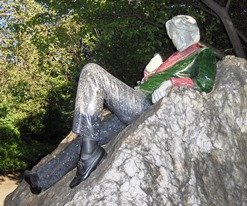 The Oscar Wilde sculpture in the capital's Merrion Square is opposite the house where the writer was born in 1854.
The Oscar Wilde sculpture in the capital's Merrion Square is opposite the house where the writer was born in 1854.Dubliners have a number of nicknames, among them the Dubs, the Metropolitans, the Jacks, the Liffeysiders and (not so politely) the Jackeens.
Surnames associated with County Dublin, based on 1890 records, include Byrne, Kelly, Doyle, Murphy, Smith, O'Brien, Kavanagh, Dunne, O'Neill, Rieilly, NOlan, Connor, Walsh and Farrell.
In 1848-51, County Dublin became the first of the counties of Ireland to be surveyed by Richard Griffith for his Valuation.
Dublin is in the province of Leinster and home to the sprawling capital city where more than a quarter of the Republic's population now lives.
 The Oscar Wilde sculpture in the capital's Merrion Square is opposite the house where the writer was born in 1854.
The Oscar Wilde sculpture in the capital's Merrion Square is opposite the house where the writer was born in 1854.The city that was to become this capital was first settled by Celts in AD140 and became a Viking base in AD860. The former settlement was known as Ath Cliath, meaning Hurdle Ford; this is the Irish language name for the city.
The Viking settlement was known as An Dubh Linn, meaning Black Pool of Water; the anglicised version of this name is Dublin.
Dubliners have a number of nicknames, among them the Dubs, the Metropolitans, the Jacks, the Liffeysiders and (not so politely) the Jackeens.
Dublin surnames, based on 1890 records, include Byrne, Kelly, Doyle, Murphy, Smith, O'Brien, Kavanagh, Dunne, O'Neill, Nolan, Connor and Farrell.
In 1848-51, Dublin became the first of the counties of Ireland to be surveyed by Richard Griffith for his Valuation.
